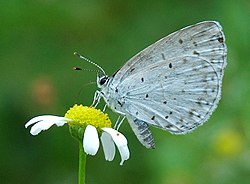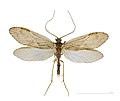| Panorpida | |
|---|---|
 | |
| Celastrina argiolus | |
| Scientific classification | |
| Domain: | Eukaryota |
| Kingdom: | Animalia |
| Phylum: | Arthropoda |
| Class: | Insecta |
| Clade: | Aparaglossata |
| Superorder: | Panorpida |
| Clades | |
Panorpida or Mecopterida is a Superorder of Holometabola. The conjectured monophyly of the Panorpida is historically based on morphological evidence, namely the reduction or loss of the ovipositor and several internal characteristics, including a muscle connecting a pleuron and the first axillary sclerite at the base of the wing, various features of the larval maxilla and labium, and basal fusion of CuP and A1 veins in the hind wings. [1] [2] The monophyly of the Panorpida is supported by recent molecular data. [3] [4]
Contents
| Holometabola |
| ||||||||||||||||||||||||||||||||||||||||||||||||
| (Endopterygota) |




